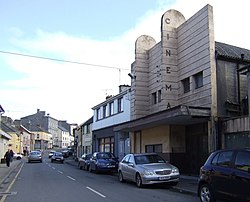Rathkeale
This article needs additional citations for verification. (November 2010) |
Rathkeale
Ráth Caola | |
|---|---|
Town | |
 Rathkeale main street, with the former Central Cinema to right | |
| Coordinates: 52°31′00″N 8°56′00″W / 52.516667°N 8.933333°W | |
| Country | Ireland |
| Province | Munster |
| County | County Limerick |
| Elevation | 45 m (148 ft) |
| Population (2016)[1] | |
| • Urban | 1,441 |
| Irish Grid Reference | R360420 |
Rathkeale (Irish: Ráth Caola, meaning 'Caola's ringfort'[2]) is a town in west County Limerick, in Ireland. It is 30 km (18 mi) southwest of Limerick city on the N21 road to Tralee, County Kerry, and lies on the River Deel. Rathkeale has a significant Irish Traveller population, and the largest concentration of descendants of the German Palatines who immigrated to Ireland in the early 18th century.
Rathkeale has shopping facilities, a museum and a community college, Coláiste na Trócaire, founded in 1995. The town has a large Roman Catholic parish church, Augustinian Abbey ruins and a Church of Ireland church, Holy Trinity. As of 1995, almost half of all residents in the town were members of the traveling community.[3]
History


On the southwestern edge of the town is the 15th-century tower house of Castle Matrix. The castle was built as a fortress during the early 1400s by Thomas FitzGerald, 7th Earl of Desmond, and was later the home of Maurice FitzGerald, 9th Earl of Desmond. It contains a display of art objects and holds historical records and is one of a series of significant Desmond properties in County Limerick (see also Adare, Askeaton and Newcastle West).
In the cemetery of Holy Trinity Church are many gravestones bearing names of Irish Palatine families. These families came from Rheinland-Pfalz, the Rhineland Palatinate in Germany as refugees in 1709. Many of their descendants now live in North America,[4] though the region around Castle Matrix in the villages of Killeheen, Ballingrane, and Courtmatrix contains the largest concentration of Palatine descendants in Ireland. Rathkeale's former railway station on the closed North Kerry railway line from Limerick to Tralee has been converted into the Irish Palatine Museum.
Transport
Rathkeale railway station opened on 1 January 1867, closed for passenger traffic on 4 February 1963 and finally closed altogether on 2 December 1974.[5] The Great Southern Trail an off-road trail for cyclists and walkers is a greenway rail trail which follows the route of the former Limerick-Tralee railway line between Rathkeale and Abbeyfeale.[6]
People
- Sean (Jackie) Finn, Brigadier of the 4th (Rathkeale) West Limerick Battalion of the IRA during the Irish War of Independence was a native of Rathkeale. His grave in the local graveyard features an impressive Celtic cross.
- The town is reportedly home to many members of the Rathkeale Rovers crime group, who own much of the property within the town.[7]
Sport

There is a large GAA grounds in Rathkeale called Mick Neville Park [8]
See also
References
- ^ "Census 2016 - Small Area Population Statistics (SAPMAP Area) - Settlements - Rathkeale". Census 2016. Central Statistics Office.
- ^ "Rathkeale History & Heritage | Limerick.ie". www.limerick.ie. Retrieved 25 November 2020.
- ^ "Rathkeale A Unique Town". RTÉ Archives. Retrieved 25 November 2020.
- ^ http://www.irishpalatines.org/about/landmarks.html
- ^ "Rathkeale station" (PDF). Railscot - Irish Railways. Retrieved 23 November 2007.
- ^ "Home". Great Southern Trail. Retrieved 10 August 2011.
- ^ "A small Irish town swollen by the proceeds of crime". The Independent. 29 February 2016. Retrieved 25 November 2020.
- ^ "Mick Neville Park".


